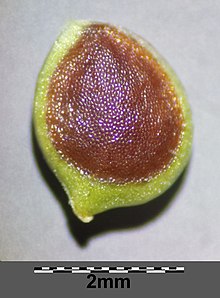Sardinian buttercup
| Sardinian buttercup | ||||||||||||
|---|---|---|---|---|---|---|---|---|---|---|---|---|

Sardinian buttercup ( Ranunculus sardous ) |
||||||||||||
| Systematics | ||||||||||||
|
||||||||||||
| Scientific name | ||||||||||||
| Ranunculus sardous | ||||||||||||
| Crantz |
The Sardinian buttercup ( Ranunculus sardous ), also called rough buttercup , is a species of the genus buttercup ( Ranunculus ) within the buttercup family (Ranunculaceae).
description
Vegetative characteristics
The Sardinian buttercup is a deciduous, biennial herbaceous plant and reaches heights of 10 to 30 centimeters. The thick hair ( indument ) of the hollow stem is particularly characteristic .
Generative characteristics
In addition to Ranunculus bulbosus, the Sardinian buttercup is the only Central European buttercup species ( Ranunculus ) with folded-back cup-like tepals , which are half as long as the vivid yellow, petal-like honey leaves .
Chromosome number
It is diploidy and tetraploidy before, the number of chromosomes is 2n = 16, 32 or 48th
ecology
The Sardinian buttercup is a helomorphic therophyte .
The pollination is done by insects or self-pollination. The diaspores spread through the wind or Velcro.
It is a moisture and soil compaction indicator that is also salt bearing.
Occurrence and endangerment
It is widespread in Europe and North Africa and is a neophyte in many areas of the world . The distribution area of the Sardinian buttercup extends in Europe from Spain and Great Britain to Sicily and the Balkan Peninsula , in the east to Ukraine and in the north to southern Sweden .
The Sardinian buttercup colonizes moist to wet fields, short-lived weed meadows , creeping and stepping lawns , damp roadsides and ditches. It thrives on moist, temporarily flooded, nutrient-rich, mostly low-lime, mild to moderately acidic, humus-rich or raw clay soils. He is in Central Europe representative of the Association Myosuro-Ranunculetum sardoi comes but the associations Agropyro-Rumicion, Cynosurion or Aperion also Centunculo-Anthoceretum the Association Nanocyperion and in other societies.
The Sardinian buttercup is safe in Central Europe. In Germany in 1996 it was rated 3 = endangered on the Red List . According to the Federal Species Protection Ordinance (BArtSchV) is "not particularly protected". The elimination of arable land , intensified agriculture and the draining of wet meadows endanger the rough buttercup.
Systematics
Ranunculus sardous was first published in 1763 by Heinrich Johann Nepomuk von Crantz in Stirpium Austriarum Fasciculus , 2, p. 84. A synonym for Ranunculus sardous Crantz is, for example, Ranunculus parvulus L.
Ranunculus sardous occurs in Europe in two subspecies:
- Ranunculus sardous subsp. sardous
- Ranunculus sardous subsp. xatardii (Lapeyr.) Rouy & Fouc.
supporting documents
Individual evidence
- ↑ a b c d e f g Ranunculus sardous Crantz, Sardinian buttercup. In: FloraWeb.de.
- ^ A b Ranunculus sardous at Tropicos.org. Missouri Botanical Garden, St. Louis, accessed March 28, 2015.
- ↑ a b c Erich Oberdorfer : Plant-sociological excursion flora for Germany and neighboring areas . With the collaboration of Angelika Schwabe and Theo Müller. 8th, heavily revised and expanded edition. Eugen Ulmer, Stuttgart (Hohenheim) 2001, ISBN 3-8001-3131-5 , pp. 409 .
- ^ A b Ranunculus sardous in the Germplasm Resources Information Network (GRIN), USDA , ARS , National Genetic Resources Program. National Germplasm Resources Laboratory, Beltsville, Maryland. Retrieved March 28, 2015.
- ↑ a b Jaakko Jalas, Juha Suominen (ed.): Atlas Florae Europaeae. Distribution of Vascular Plants in Europe. 8. Nymphaeaceae to Ranunculaceae. Akateeminen Kirjakauppa, The Committee for Mapping the Flora of Europe & Societas Biologica Fennica Vanamo, Helsinki 1989, ISBN 951-9108-07-6 , pp. 141-142.
literature
- Eckehart J. Jäger, Klaus Werner (Ed.): Excursion flora from Germany . Founded by Werner Rothmaler. 10th edited edition. tape 4 : Vascular Plants: Critical Volume . Elsevier, Spektrum Akademischer Verlag, Munich / Heidelberg 2005, ISBN 3-8274-1496-2 .
- Franz Fukarek , Heinz executioner : Flora of Mecklenburg-Western Pomerania. Fern and flowering plants . Weissdorn, Jena 2006, ISBN 3-936055-07-6 .
Web links
- Sardinian buttercup. In: FloraWeb.de.
- Sardinian buttercup . In: BiolFlor, the database of biological-ecological characteristics of the flora of Germany.
- Profile and distribution map for Bavaria . In: Botanical Information Hub of Bavaria .
- Ranunculus sardous Crantz In: Info Flora , the national data and information center for Swiss flora . Retrieved October 19, 2015.
- Distribution in the northern hemisphere
- Thomas Meyer: Data sheet with identification key and photos at Flora-de: Flora von Deutschland (old name of the website: Flowers in Swabia )





